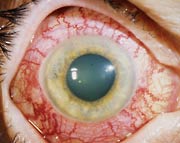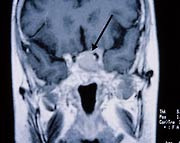Recognizing signs, symptoms could lead to a more accurate diagnosis in diplopia
A physician offers advice on red flags that may show a patient has life-threatening disease.
![OSN Hawaii [logo]](/~/media/images/shared-images/osn-hawaii-logo.jpg) It is important for ophthalmologists to recognize certain symptoms when diagnosing the cause of diplopia, Andrew G. Lee, MD, told attendees at Hawaii 2005, The Royal Hawaiian Eye Meeting. He made a presentation on diagnosing and treating patients with diplopia.
It is important for ophthalmologists to recognize certain symptoms when diagnosing the cause of diplopia, Andrew G. Lee, MD, told attendees at Hawaii 2005, The Royal Hawaiian Eye Meeting. He made a presentation on diagnosing and treating patients with diplopia.
“My goals are to recognize life-threatening etiologies for diplopia, to define some emergent red flags that tell you to image this person and to describe the key clinical findings that will help you make the specific clinical diagnosis,” he said.
Myasthenia gravis
Myasthenia gravis (MG) should be considered in every case of diplopia, according to Dr. Lee. As an example, he referenced a patient with ptosis who had unusual third nerve palsy. “When you end up with weird third neuropalsy, you should be thinking about myasthenia gravis in any painless, pupil-spared, nonproptotic ophthalmoplegia,” he said. “It can always be myasthenia.”
Be aware of fatigue, variability of intermittent symptoms, ptosis with or without ophthalmoplegia, and bilateral or unusual motility findings, especially isolated rectus palsy, Dr. Lee said.
“Systemic myasthenia can be life-threatening,” he said. “Topical and systemic medications can worsen myasthenia gravis. It’s called gravis for a reason, and that reason is myasthenia gravis still kills people.”
Some of the most common errors in evaluating myasthenia gravis include failure to consider MG in a diagnosis and operating on a patient with MG after only one office visit.
“Pain, proptosis, pupil involvement, paresthesias in the trigeminal distribution excludes diagnosis of myasthenia gravis,” Dr. Lee said.
Cancer patients
Dr. Lee said it is important to “be a doctor first and an ophthalmologist second.
“Being a doctor first means looking at a past medical history for cancer,” he said. He noted a case of a 65-year-old patient with breast cancer and chronic sixth nerve palsy with a normal CT scan.
“A normal CT scan is a false sense of security … it is cancer until proven otherwise,” he said. “A third of those patients [with chronic sixth nerve palsy] have an underlying intracranial lesion that needs to be imaged and imaged again until you find it.”
The clivus and the cavernous sinus are the two locations where a CT scan will often miss a compressive lesion, such as a meningioma, chordoma or metastasis, he said.
Not just red eye
 Arterialization of the conjunctival vessels is seen in carotid cavernous fistula. | ||
 MRI scan of sphenoid sinus shows mucormycosis. Images: Lee A |
Patients are sometimes sent to neuro-ophthalmology for chronic red eye that has been unresponsive to drops, he said.
“If it’s red eye plus ophthalmoplegia, red eye plus proptosis, red eye plus loss of vision from an optic neuropathy, it is fistula until proven otherwise,” he said.
Carotid cavernous fistula patients should undergo diagnostic and therapeutic angiography, Dr. Lee said.
“The key and distinctive sign is tortuous and dilated arterials that go up to the limbus and wind their way back,” Dr. Lee said. “The intervening conjunctiva is white. That is a distinctive sign.”
The corkscrew-like arterials are a sign that it is not just red eye, he said.
“The cavernous sinus also has venous drainage from the cortex, and if you have a cortical drainage that hemorrhages or infarcts, you will have a venous cortical infarct,” he said. “And that can kill you.”
Ophthalmoplegia in diabetics
A diabetic patient with a mass in the cavernous or sphenoid sinus with ophthalmoplegia or optic neuropathy has mucormycosis or aspergillosis until proven otherwise and should be imaged right away, Dr. Lee said.
“So you should be considering any patient who has sinus disease with an ophthalmoplegia to have intraorbital extension [of the disease into the orbit],” he said. “The characteristic and classic black eschar is an uncommon and late finding, and I would not rely upon that.”
Instead, begin debridement and antifungal treatment immediately because the conditions are life threatening, he said.
“Most diabetic palsies are benign, but a vasculopath is allowed only one cranial neuropathy at a time,” he said. “So if you look down and the impression is diabetes with partial third and sixth, you have the wrong diagnosis. You should be thinking MG in that patient, or a compressive lesion needs to be imaged.”
Also be aware of pain, complete ophthalmoplegia and optic neuropathy because they are signs of orbital apex involvement, Dr. Lee said.
Count to seven
Count to seven for every patient with diplopia, Dr. Lee said.
“It is your obligation as a doctor first and an ophthalmologist second to be able to count to seven,” Dr. Lee said. “They [the cranial nerves] are numbered for a reason. If you’re only checking three, four and six, you are skipping two cranial nerves, five and seven, that are critically important for localization.”
It is important to check trigeminal function and orbicularis function on every patient with diplopia to localize and isolate the palsy.
“Your only job on day 1 is to make sure it’s not a compressive lesion,” he said.
Headache
“You should be worried about pituitary apoplexy with any patient who complains of a new onset headache and has a bitemporal hemianopsia or any cranial neuropathy, especially young females,” Dr. Lee said. “They should be imaged that day.”
Dr. Lee presented a case of a 25-year-old patient who complained of the “worst headache in her life.” She had nausea, vomiting and a suggestion of bitemporal field loss with third nerve palsy.
“That is pituitary apoplexy until proven otherwise, and apoplexy of the pituitary gland can kill you,” he said.
Aneurysm
The highest risk encounter that most ophthalmologists will see is an aneurysm in a patient with third nerve palsy.
“One patient is a vasculopath, and the other person has an aneurysm,” he said. “The vasculopathic diabetic with third nerve palsy will be fine. It will go away. If it’s an aneurysm, the patient will die. Fifty percent of people will rupture and die at the scene. Of those who survive, half will be permanently neurologically impaired.”
The finding in the eye clinic that determines this is the pupil exam, he said.
“A single-eye finding of an involved third nerve palsy is an aneurysm of the posterior communicating artery until proven otherwise, and you need to image that person, and when the pupil is involved you probably need an MRI/MRA combination or a CTA combination followed by a standard catheter angiogram,” he said.
For Your Information:
- Andrew G. Lee, MD, can be reached at Department of Ophthalmology and Visual Sciences, University of Iowa, 200 Hawkins Drive, Iowa City, IA 52242-1091; 319-384-7372; fax: 319-356-0363.
- Daniele Cruz is an OSN Staff Writer who covers all aspects of ophthalmology.
